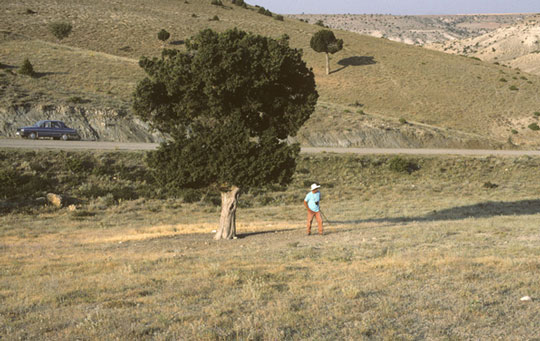Archaeobotany
Considering that it lies in the temperate zone, Turkey has a very diverse flora and a large number of endemic species. In the Gordion region, precipitation and tree cover decline with elevation. People have occupied the area for millennia, engaging in both farming and herding, so the vegetation cover is not pristine. Nevertheless, both vegetation and land use follow those rainfall clines. The flora has been forced to adapt to a very erratic climate, as well.


Naomi F. Miller joined the Gordion Project as the archaeobotanist in the late 1980s, and since the 1990s she has been concerned with vegetation improvement and archaeological preservation on an increasingly large scale, a project referred to as “The Ecopark.” This has involved planting vegetation closer to the tourist attractions of the site and museum, especially as a way to diminish erosion. One of the focal points has been Tumulus MM, where erosion has increased substantially. Even though the mound itself was nearly bare, there clearly was a seed bank waiting to sprout amid the spiny shrubs, and it had an opportunity to grow once the perimeter of the mound was fenced.
On the Citadel Mound of Gordion, one has to keep the vegetation in check both to protect the ruins and to make them visible for tourists. Yet one can also use the vegetation strategically in preservation activities, especially when dealing with ruined walls, such as those that form part of Gordion’s Terrace Buildings. The upper section of the walls is covered with a layer of soil, and the seeds of native grasses and other shallow-rooted plants are set into it, in the form of mudballs. Such a system avoids insect predation, and essentially fools the seeds into thinking they are in a natural setting as the mudballs are melted by the winter rains. The result is a stable cap that protects the walls and delineates them more clearly for visitors to the site.

The plant remains excavated at Gordion come primarily from accidentally burnt food and intentionally burnt fuel. The woody vegetation available to the ancient inhabitants changed between the Late Bronze Age and the Medieval period. To this day, the major woodland types grow (pine, oak, and juniper), but over time there has been a gradual increase in the use of trees of secondary forest (e.g. hawthorn) and riparian types (e.g. willow/poplar).
The seed remains suggest a very diverse animal diet (i.e. there is a wide variety of wild types that show up in animal dung burned as fuel) and a fairly standard human diet—at least the plant-based part of it (bread wheat, einkorn wheat, barley, lentil; bitter vetch might be animal fodder). Other food remains have been recovered occasionally: flax, hazel, cherry, wild almond, and chickpea.
Further reading
- Miller, N. F. 2010. Botanical Aspects of Environment and Economy at Gordion, Turkey. University of Pennsylvania Museum, Philadelphia.
- Miller, N. F. 2011. “Managing Predictable Unpredictability: The Question of Agricultural Sustainability at Gordion,” in Sustainable Lifeways: Cultural Persistence in an Ever-changing Environment, eds. N.F. Miller, K.M. Moore, and K. Ryan, pp. 310-324. University of Pennsylvania Museum, Philadelphia.
- Miller, Naomi F., Melinda A. Zeder, and Susan R. Arter. 2009. “From Food and Fuel to Farms and Flocks: The Integration of Plant and Animal Remains in the Study of Ancient Agropastoral Economies at Gordion, Turkey,” Current Anthropology 50, pp. 915-924.
Links
See the following pages for information on:

